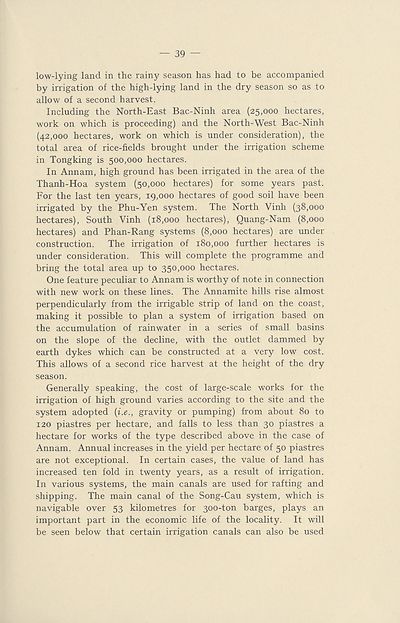Health > Intergovernmental conference of Far-Eastern countries on rural hygiene : preparatory papers : report of French Indo-China
(41)
Download files
Complete book:
Individual page:
Thumbnail gallery: Grid view | List view

— 39 —
low-lying land in the rainy season has had to be accompanied
by irrigation of the high-lying land in the dry season so as to
allow of a second harvest.
Including the North-East Bac-Ninh area (25,000 hectares,
work on which is proceeding) and the North-West Bac-Ninh
(42,000 hectares, work on which is under consideration), the
total area of rice-fields brought under the irrigation scheme
in Tongking is 500,000 hectares.
In Annam, high ground has been irrigated in the area of the
Thanh-Hoa system (50,000 hectares) for some years past.
For the last ten years, 19,000 hectares of good soil have been
irrigated by the Phu-Yen system. The North Vinh (38,000
hectares), South Vinh (18,000 hectares), Quang-Nam (8,000
hectares) and Phan-Rang systems (8,000 hectares) are under
construction. The irrigation of 180,000 further hectares is
under consideration. This will complete the programme and
bring the total area up to 350,000 hectares.
One feature peculiar to Annam is worthy of note in connection
with new work on these lines. The Annamite hills rise almost
perpendicularly from the irrigable strip of land on the coast,
making it possible to plan a system of irrigation based on
the accumulation of rainwater in a series of small basins
on the slope of the decline, with the outlet dammed by
earth dykes which can be constructed at a very low cost.
This allows of a second rice harvest at the height of the dry
season.
Generally speaking, the cost of large-scale works for the
irrigation of high ground varies according to the site and the
system adopted {i.e., gravity or pumping) from about 80 to
120 piastres per hectare, and falls to less than 30 piastres a
hectare for works of the type described above in the case of
Annam. Annual increases in the yield per hectare of 50 piastres
are not exceptional. In certain cases, the value of land has
increased ten fold in twenty years, as a result of irrigation.
In various systems, the main canals are used for rafting and
shipping. The main canal of the Song-Cau system, which is
navigable over 53 kilometres for 300-ton barges, plays an
important part in the economic life of the locality. It will
be seen below that certain irrigation canals can also be used
low-lying land in the rainy season has had to be accompanied
by irrigation of the high-lying land in the dry season so as to
allow of a second harvest.
Including the North-East Bac-Ninh area (25,000 hectares,
work on which is proceeding) and the North-West Bac-Ninh
(42,000 hectares, work on which is under consideration), the
total area of rice-fields brought under the irrigation scheme
in Tongking is 500,000 hectares.
In Annam, high ground has been irrigated in the area of the
Thanh-Hoa system (50,000 hectares) for some years past.
For the last ten years, 19,000 hectares of good soil have been
irrigated by the Phu-Yen system. The North Vinh (38,000
hectares), South Vinh (18,000 hectares), Quang-Nam (8,000
hectares) and Phan-Rang systems (8,000 hectares) are under
construction. The irrigation of 180,000 further hectares is
under consideration. This will complete the programme and
bring the total area up to 350,000 hectares.
One feature peculiar to Annam is worthy of note in connection
with new work on these lines. The Annamite hills rise almost
perpendicularly from the irrigable strip of land on the coast,
making it possible to plan a system of irrigation based on
the accumulation of rainwater in a series of small basins
on the slope of the decline, with the outlet dammed by
earth dykes which can be constructed at a very low cost.
This allows of a second rice harvest at the height of the dry
season.
Generally speaking, the cost of large-scale works for the
irrigation of high ground varies according to the site and the
system adopted {i.e., gravity or pumping) from about 80 to
120 piastres per hectare, and falls to less than 30 piastres a
hectare for works of the type described above in the case of
Annam. Annual increases in the yield per hectare of 50 piastres
are not exceptional. In certain cases, the value of land has
increased ten fold in twenty years, as a result of irrigation.
In various systems, the main canals are used for rafting and
shipping. The main canal of the Song-Cau system, which is
navigable over 53 kilometres for 300-ton barges, plays an
important part in the economic life of the locality. It will
be seen below that certain irrigation canals can also be used
Set display mode to:
![]() Universal Viewer |
Universal Viewer | ![]() Mirador |
Large image | Transcription
Mirador |
Large image | Transcription
Images and transcriptions on this page, including medium image downloads, may be used under the Creative Commons Attribution 4.0 International Licence unless otherwise stated. ![]()
| League of Nations > Health > Intergovernmental conference of Far-Eastern countries on rural hygiene : preparatory papers : report of French Indo-China > (41) |
|---|
| Permanent URL | https://digital.nls.uk/191084994 |
|---|
| Shelfmark | LN.III |
|---|---|
| Description | Over 1,200 documents from the non-political organs of the League of Nations that dealt with health, disarmament, economic and financial matters for the duration of the League (1919-1945). Also online are statistical bulletins, essential facts, and an overview of the League by the first Secretary General, Sir Eric Drummond. These items are part of the Official Publications collection at the National Library of Scotland. |
|---|---|
| Additional NLS resources: |
|

